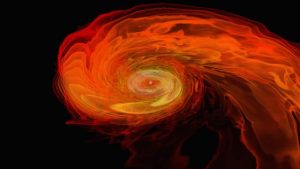
Asteroid Impact that killed the dinosaurs (Source: Wikimedia Commons)
Sixty-six million years ago, a massive asteroid crashed into Earth. The explosion from the impact released energy equivalent to 100 trillion tons of TNT. The mass extinction that occurred afterwards wiped out about 80% of all species at the time, including the dinosaurs. What if there was a way to predict such a catastrophe?
Do Mass Extinctions Follow a Pattern?
In 1984, researchers Raup and Sepkoski compiled data on twelve recent extinction events. Using statistics, they analyzed the data and found that a mass extinction seemed to occur about every 26 million years. This finding led to a torrent of research as scientists sought to replicate and explain this phenomenon.
The Solar System’s Journey through the Milky Way
One of the most prominent explanations were suggested by Rampino and Stothers. They proposed this pattern had something to do with our sun’s movement within the Milky Way galaxy. Just like how the earth revolves around the sun, the sun also revolves around the centre of our spiral galaxy. As the sun orbits, it also oscillates above and below the spiral arm. The gravity within our solar system fluctuates along with this vertical movement.

The sun’s orbit around Milky Way (Source: Wikimedia Commons)
According to Rampino and Stothers, the changes in gravity has an important impact on the Oort Cloud, a cluster of asteroids in the outer reaches of our solar system. When the sun is located right within the galaxy arm, the gravity from this densely packed region disturbs the Oort Cloud. As a result, Oort Cloud comets are deflected into the inner solar system, where any one of them can crash onto Earth, potentially causing a mass extinction similar to the one that killed the dinosaurs.
Oort Cloud (Source: Wikimedia Commons)
Counterargument
Equally many scientists have also criticized the existence of the 26-million-year pattern. For example, in his study, John Alroy claimed that the proposed pattern did not agree with data documenting mass extinctions of marine animals. In addition, Bailer-Jones pointed out flaws in Raup and Sepkoski’s statistics. She wrote that there were extinction events in the data that Raup and Sepkoski had omitted from the calculations. Furthermore, she noted the dates of the extinction events were uncertain, which Raup and Sepkoski did not account for. As a result, Bailer-Jones felt that Raup and Sepkoski’s calculations were not significant enough to draw such bold conclusions. Instead, she felt there’s more evidence that mass extinctions are sporadic, caused by multiple factors, including climate change.
Conclusion
The idea that mass extinctions occur at a predictable rate is both terrifying and fascinating. However, scientists are still debating whether such a pattern really exists. In the meantime, we can focus on other causes of mass extinctions. Specifically, ones we can control. Asides from meteor impacts, global warming is also a major cause of mass extinctions and there’s not need to predict that our planet is warming at an unprecedented rate.
-Written by Helen Hu


